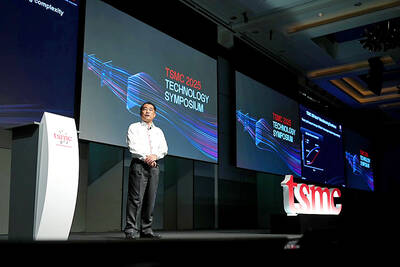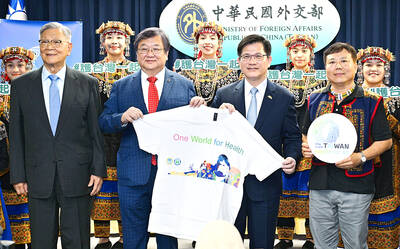Economic growth in developing nations in the Asia-Pacific region will fall slightly this year to 7.7 percent, the UN said yesterday, but buoyed by booming India and China, it will likely weather a slowdown in the US.
The region is entering a phase of "heightened uncertainty," the UN report said, with export-led countries to be hardest hit by the ongoing financial turmoil in the US.
"In the worst case scenario of a recession in the US and a deeper depreciation of the dollar, the impact in much of the region would be harsh," the report said.
"Most vulnerable will be the exporters of high-technology products, such as electronics, to the US: Singapore, South Korea and Taiwan," said the report outlining the economic and social situation for the region for this year.
After a record GDP growth of 8.2 percent last year, global factors including high oil and food prices prices would take a toll in the region, the report by the UN Economic and Social Commission for Asia and the Pacific (ESCAP) said.
Rich countries in the region including Japan, Australia and New Zealand will see growth drop to 1.6 percent this year from 2 percent last year, it said.
But China and India's economies would continue chugging along, offering opportunities to other export-led economies.
India is expected to maintain growth at 9 percent this year while in China, government spending increases will spur domestic demand.
"China and India, the region's growth locomotives, are expected to grow at a robust pace, boosting growth in the region," ESCAP deputy executive secretary Shigeru Mochida said.
"So far the Asia Pacific region has been resilient -- it is mainly due to the good and strong economic fundamentals," he told reporters at the Bangkok launch of their report.
Maintaining these fundamentals by moderating inflation and keeping budget deficits and interest rates low was key to weathering turmoil in the world's largest economy, sparked by the housing crisis and credit crunch, he said.
Exporters would face a double whammy of a weakening dollar due to sharply lowered interest rates in the US, as well as slowing demand.
Inflation, meanwhile, is projected at 4.6 percent this year in developing nations, down from 5.1 percent the previous year.
Soaring food prices were a major concern, UN officials said, while agriculture was in need of drastic reform, with government neglect of the sector helping keep 641 million people in the region in poverty.
"Something must be very wrong in the current approach to development if it leaves millions of people in extreme poverty, when so much prosperity has been generated in such a short time," Mochida said.
But even with the credit crunch casting a pall over export-led economies, the financial turmoil is also throwing up opportunities.
"Interest in Asia-Pacific assets may increase because of the strong growth projections for the region," the ESCAP report said.
In addition, sovereign wealth funds in the region are increasingly being tapped to help bolster weakened banks in the US and Europe.
The report also said the region's corporations, being "cash rich and not highly leveraged" have been largely resilient to the US credit crunch.

DEMOGRAPHICS: Robotics is the most promising answer to looming labor woes, the long-term care system and national contingency response, an official said Taiwan is to launch a five-year plan to boost the robotics industry in a bid to address labor shortages stemming from a declining and aging population, the Executive Yuan said yesterday. The government approved the initiative, dubbed the Smart Robotics Industry Promotion Plan, via executive order, senior officials told a post-Cabinet meeting news conference in Taipei. Taiwan’s population decline would strain the economy and the nation’s ability to care for vulnerable and elderly people, said Peter Hong (洪樂文), who heads the National Science and Technology Council’s (NSTC) Department of Engineering and Technologies. Projections show that the proportion of Taiwanese 65 or older would

Nvidia Corp yesterday unveiled its new high-speed interconnect technology, NVLink Fusion, with Taiwanese application-specific IC (ASIC) designers Alchip Technologies Ltd (世芯) and MediaTek Inc (聯發科) among the first to adopt the technology to help build semi-custom artificial intelligence (AI) infrastructure for hyperscalers. Nvidia has opened its technology to outside users, as hyperscalers and cloud service providers are building their own cost-effective AI chips, or accelerators, used in AI servers by leveraging ASIC firms’ designing capabilities to reduce their dependence on Nvidia. Previously, NVLink technology was only available for Nvidia’s own AI platform. “NVLink Fusion opens Nvidia’s AI platform and rich ecosystem for

Taiwan Semiconductor Manufacturing Co (TSMC, 台積電) yesterday said it is building nine new advanced wafer manufacturing and packaging factories this year, accelerating its expansion amid strong demand for high-performance computing (HPC) and artificial intelligence (AI) applications. The chipmaker built on average five factories per year from 2021 to last year and three from 2017 to 2020, TSMC vice president of advanced technology and mask engineering T.S. Chang (張宗生) said at the company’s annual technology symposium in Hsinchu City. “We are quickening our pace even faster in 2025. We plan to build nine new factories, including eight wafer fabrication plants and one advanced

‘WORLD’S LOSS’: Taiwan’s exclusion robs the world of the benefits it could get from one of the foremost practitioners of disease prevention and public health, Minister Chiu said Taiwan should be allowed to join the World Health Assembly (WHA) as an irreplaceable contributor to global health and disease prevention efforts, Minister of Foreign Affairs Lin Chia-lung (林佳龍) said yesterday. He made the comment at a news conference in Taipei, hours before a Taiwanese delegation was to depart for Geneva, Switzerland, seeking to meet with foreign representatives for a bilateral meeting on the sidelines of the WHA, the WHO’s annual decisionmaking meeting, which would be held from Monday next week to May 27. As of yesterday, Taiwan had yet to receive an invitation. Taiwan has much to offer to the international community’s